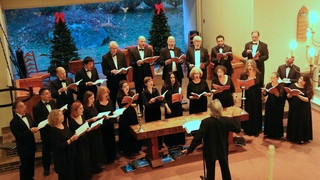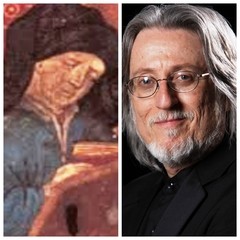|
Back
Tis the Season for Gibbons (And Receivings) New York
St.Michael’s Episcopal Church
12/14/2019 - & December 8, 2019 (Katonah)
Spanish 16th Century: E la Don Don, Verges Maria
Guillaume de Machaut: Gloria from the Messe de Notre Dame
Orlando Gibbons: See, See The Word is Incarnate
Gustav Holst: In the Bleak Mid-Winter, H. 73, No. 1
Harold Darke: In the Bleak Mid-Winter
Benjamin Britten: A boy was born, opus 3: Var. 5. “In The Bleak Mid-Winter” – Saint Nicolas, opus 42: VIII. “His Piety and His Marvelous Works”
Simon Frisch: In Bedlem, That Fayer Cyte
Richard Rice: Adam Lay y Bounden
Thea Musgrave: Two Christmas Carols in Traditional Style
George Perle: The Miracle of Saint Nicholas
J. Fred Coots: Santa Claus is Comin’ to Town (Arranged by Don Besig)
Karina Parker, Julianne Froelich, Christina Swanson (Sopranos), Alexa Fields von Blijdesteijn, Art Manabat, Elizabeth Adler, Laura Cosmich (Altos), Ian Barnes, Nicholas Prior, Travis Washington (Tenors), Jake Forrestal, Sam Fuji (Baritones), David Enlow (Organ, Piano), Nicholas Prior (Assistant Conductor), Harold Rosenbaum (Conductor)

Canticum Novum (© Courtesy of the artists)
“Like young scholars, my compositions were taught to sing only to delight you, and if you shall take any pleasure in them, they have their end, and I my wish.”
Orlando Gibbons (1583-1625)
“He who makes songs without feeling spoils both his words and his music.”
Guillaume de Machaut (1300-1377)
Like the Holy Family fleeing the wrath of King Herod, the Manhattan music-scribe-tribe make desperate attempts this month to flee Messiah and Ceremony of Carols and Christmas Oratorio. All of them honorable opuses (to say the least). But they take over the churches the way Perry Como and Bing Crosby take over the supermarkets.
Enough is enough.
Thus, when Canticum Novum, that most exciting choral group for almost half a century, announced a program including Guillaume de Machaut and Arnold Schoenberg, this tribal member made a trip to the beautiful St. Michael’s Church way uptown to see what was in store.
One disappointment, that Schoenberg was off the program. His only Christmas music was for orchestra, so that was no problem. Anyhow, Canticum Novum had scheduled that amiable atonalist George Perle with his The Miracle of Saint Nicholas, so I was anxious to see how jolly old St. Nick would respond to dodecaphony.
That was not to be. The marvelous Mr. Perle held in his inner complexities and–like the rest of the music last night–presented an amiable beautifully woven-together song, beautifully sung.
BR />
Conductor Harold Rosenbaum did arrange a most amiable program: religious, yes, but not terribly solemn. And when you follow Perle and Benjamin Britten with Santa Claus is Comin’ to Town (solemnly attributed to J. Fred Coots) it was obvious that Mr. Rosenbaum was not a Christmas-denier.
The dozen selections were divided in half by an intermission (the second half was 20th Century). But equally divided into four sensible partitions: “Antiquity”, “In The Bleak Mid-Winter”, “The Birth” and, yes, “Saint Nicholas.”
The three Renaissance openers gave singular indication of Canticum Novum. Doubtless, they can be as grave as necessary. But the three offerings, from 16th Century Spain, from one of England’s most inventive composers, Orlando Gibbons, and from the finest poet/composer prior to Stephen Sondheim, Guillaume (“Bill”) de Machaut.
All three with some excellent vocal consorts were given a sustained excitement, more an elation than a religious coverlet.

G. de Machaut/H. Rosenbaum
“In The Bleak Mid-Winter” was based on a poem by Christina Georgina Rossetti, with three composers trying their luck. Canticum Novum sung so clearly, so transparently, that one could ignore that Holst have written a rather pedestrian strophic setting. More imaginative was a setting by one Harold Darke (Wikipedia tells me he was a church composer.)
Of course it was Benjamin Britten’s setting that was most stunning. Most of the sopranos and altos departed for the back of the church, so that Canticum Novum gave us an antiphonal song, a rapturous addition to Rossetti’s oh so beautiful poem.
The three hymn/songs of “The Birth” were forgettable, save for Thea Musgrave’s sheerly wondrous settings of two original carols.
The “Saint Nicholas” section was most intriguing. I once came across the original icon of the Saint near his birthplace in Turkey, and he looked like a most unpleasant unforgiving old man. Apostates should keep their distance!
Clement Moore–whose confidante in America was Mozart’s librettist, Lorenzo da Ponte–saved the Venerable Elder for eternity.
Thus after George Perle’s simple tonal song was an appropriate apologia. Benjamin Britten treated the Saint with historic perspective (which was good), and his cantata Saint Nicolas, penned for amateur choirs, is a lovely piece.
Canticum Novum, though, is a professional choir. I missed the usual boys’ voices, the wavering altos and sopranos of this delicious work.
Finally Mr. Coots’s contribution. He was not a hack songwriter, though hardly in the pantheon of 1930’s pop composers. Santa Claus Is Coming to Town has made him immortal. And this was where the congregation of Canticum Novum was transformed into a choir of its own, singing with adequate jollity, cheer and well-deserved appreciation of Mr. Rosenbaum and his choir of Yuletide joy.
Harry Rolnick
|